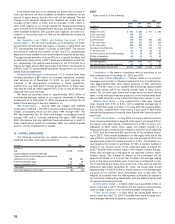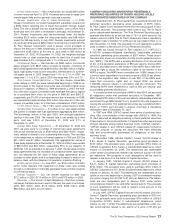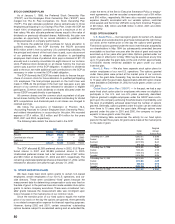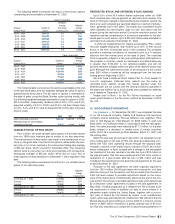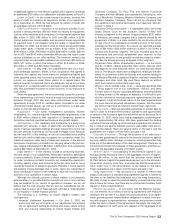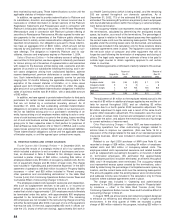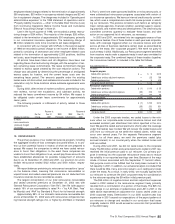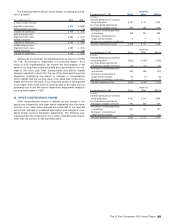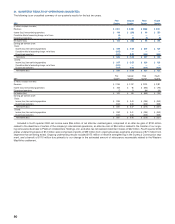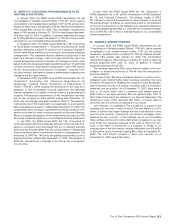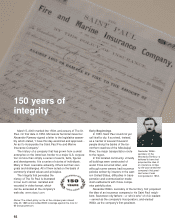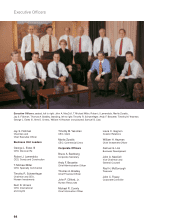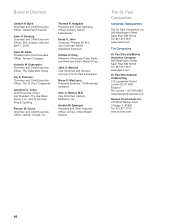Travelers 2002 Annual Report Download - page 88
Download and view the complete annual report
Please find page 88 of the 2002 Travelers annual report below. You can navigate through the pages in the report by either clicking on the pages listed below, or by using the keyword search tool below to find specific information within the annual report.
The effect of assumed and ceded reinsurance on premiums
written, premiums earned and insurance losses and loss adjustment
expenses is as follows (including the impact of the reinsurance
treaties).
Years ended December 31 2002 2001 2000
(In millions)
PREMIUMS WRITTEN
Direct $7,585 $7,135 $ 6,219
Assumed 1,973 2,700 2,064
Ceded (2,512) (2,072) (2,399)
Net premiums written $7,046 $7,763 $ 5,884
PREMIUMS EARNED
Direct $7,569 $6,656 $ 5,819
Assumed 2,163 2,685 2,019
Ceded (2,342) (2,045) (2,246)
Net premiums earned $7,390 $7,296 $ 5,592
INSURANCE LOSSES AND
LOSS ADJUSTMENT EXPENSES
Direct $6,955 $6,876 $ 4,068
Assumed 1,354 3,952 1,798
Ceded (2,314) (3,349) (1,953)
Net insurance losses and loss adjustment expenses $5,995 $7,479 $ 3,913
20. STATUTORY ACCOUNTING PRACTICES
Our underwriting operations are required to file consolidated finan-
cial statements with state and foreign regulatory authorities. The
accounting principles used to prepare these statutory financial state-
ments follow prescribed or permitted accounting principles, which dif-
fer from GAAP. Prescribed statutory accounting practices include
state laws, regulations and general administrative rules issued by the
state of domicile as well as a variety of publications and manuals of
the National Association of Insurance Commissioners (“NAIC”).
Permitted statutory accounting practices encompass all accounting
practices not so prescribed, but allowed by the state of domicile.
Beginning in 2001, Fire and Marine was granted a permitted practice
regarding the valuation of certain investments in affiliated limited lia-
bility companies, allowing it to value these investments at their audited
GAAP equity. Since these investments were not required to be valued
on a statutory basis, Fire and Marine is not able to determine the
impact on statutory surplus.
On a statutory accounting basis, as filed in our regulatory Annual
Statements, our property-liability underwriting operations reported net
income of $240 million in 2002, a net loss of $547 million in 2001 and
net income of $1.2 billion in 2000. Statutory surplus (shareholders’
equity) of our property-liability underwriting operations was $5.5 bil-
lion and $4.8 billion as of December 31, 2002 and 2001, respectively.
The NAIC published revised statutory accounting practices in con-
nection with its codification project, which became effective January 1,
2001. The cumulative effect to our property-liability insurance
operations of the adoption of these practices was to increase statu-
tory surplus by $126 million, primarily related to the treatment of
deferred taxes.
21. SEGMENT INFORMATION
In the fourth quarter of 2002, we revised our property-liability busi-
ness segment reporting structure to reflect the manner in which those
businesses are currently managed, particularly in recognition of cer-
tain operations being separately managed as runoff operations. As of
December 31, 2002, our property-liability underwriting operations
consist of four segments constituting our ongoing operations, and
three segments comprising our runoff operations. We retained the
concept of a “specialty commercial”business center, which is an oper-
ation possessing dedicated underwriting, claims and risk control serv-
ices requiring specialized expertise and focusing exclusively on the
customers it serves. Eleven of those business centers comprise our
Specialty Commercial reportable segment. None of those business
centers alone met the quantitative threshold to qualify as a separate
reportable segment; therefore they were combined based on the
applicable aggregation criteria. All data for 2001 and 2000 included in
86
this report were restated to be consistent with the new reporting struc-
ture in 2002.The following is a summary of changes made to our seg-
ments at the end of 2002.
• In our Specialty Commercial segment, all international specialty
business that had either been included in respective business
centers, or had been included in the separate International
Specialty business center, was reclassified to the newly formed
International & Lloyd’s segment (for ongoing operations) or our
Other segment (for international operations considered to be in
runoff).
• All international Health Care business, previously included in the
Health Care segment, was reclassified to the newly formed Other
segment.
• The International & Lloyd’s segment was formed, comprised of
our ongoing operations at Lloyd’s, ongoing specialty commercial
business underwritten outside the United States (currently con-
sisting of operations in the United Kingdom, Canada and the
Republic of Ireland), and Global Accounts. All operations in this
segment are under common management.
• The new runoff segment Other was formed, comprised of the
results of all of our international and Lloyd’s business considered
to be in runoff (including our involvement in insuring the Lloyd’s
Central Fund), as well as those of Unionamerica, the U.K.-based
underwriting entity acquired in the MMI transaction.
• Our Catastrophe Risk business center, previously included in the
Specialty Commercial segment in its entirety, was split into two,
with Personal Catastrophe Risk remaining in the Specialty
Commercial segment and Commercial Catastrophe Risk moving
to the Commercial Lines segment as part of the Property
Solutions business center.
In addition to our property-liability business segment, we also have
a property-liability investment operation segment, as well as an asset
management segment, consisting of our majority ownership in
Nuveen Investments.
The accounting policies of the segments are the same as those
described in the summary of significant accounting policies.We evalu-
ate performance based on underwriting results for our property-liabil-
ity insurance segments, investment income and realized gains for our
investment operations, and on pretax operating results for the asset
management segment. Property-liability underwriting assets are
reviewed in total by management for purposes of decision-making.We
do not allocate assets to these specific underwriting segments. Assets
are specifically identified for our asset management segment.
Geographic Areas — The following summary presents financial
data of our continuing operations based on their location.
Years ended December 31 2002 2001 2000
(In millions)
REVENUES
U.S. $7,163 $7,137 $ 6,766
Non-U.S. 1,755 1,782 1,180
Total revenues $8,918 $8,919 $ 7,946
Segment Information — After the revisions to our segment struc-
ture described above, our reportable segments in our property-liabil-
ity operations consisted of the following:
The Specialty Commercial segment includes business centers
that possess dedicated underwriting, claims and risk control services
that require specialized expertise and focus exclusively on the cus-
tomers served by those respective business centers. This segment
includes Financial & Professional Services, Technology, Public Sector
Services, Umbrella / Excess & Surplus Lines, Ocean Marine,
Discover Re, National Programs, Oil & Gas, Transportation, and
Personal Catastrophe Risk.
The Commercial Lines segment focuses on commercial clientele,
and although we target certain commercial customer groups and
industries, we do not have underwriting, claim or risk service person-
nel with specialized expertise dedicated exclusively to these groups or
industries. Accordingly, the business centers within Commercial Lines
are not considered “specialty” businesses. This reporting segment
includes Small Commercial, Middle Market Commercial and Property


